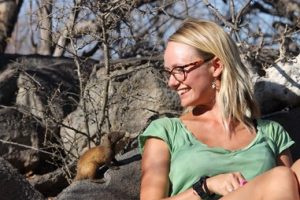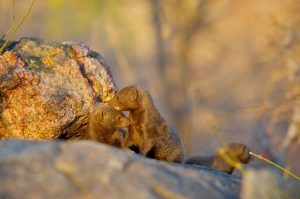Leopards, hard-boiled eggs, “yip yip yip”-ping, and faeces collecting – just a typical day in the life of dwarf mongoose field researcher Amy Morris-Drake.
Having spent a holiday in South Africa before starting her undergraduate degree in Biology at the University of Bristol, Amy Morris-Drake fell in love with the noise and colours of the African bush. At the end of 2013, having graduated, she saw an advert seeking a Research Assistant that required the applicant to go to South Africa and study the behaviour of an adorable tiny mammal entirely unknown to Amy at the time, the dwarf mongoose.
The dwarf mongoose is the smallest of the three social mongoose species found in Africa, making termite mounds their home. Collectively known as a business, dwarf mongooses measure 18–30cm from head to tail. But despite their size, dwarf mongooses are hardy creatures who work tirelessly – foraging, grooming and defending one another from rival groups and scores of predators.
 Always fascinated by animal behaviour and determined to return to Africa, Amy landed the Research Assistant job in Professor Andy Radford’s Dwarf Mongoose Research Project. She lived on Sorabi Rock Lodge reserve for 6 months, observing the creatures in their natural habitat. “It was originally going to be 3 months but I loved it and didn’t want to leave”, recalls Amy. The dwarf mongooses made such as impression that on her return to the UK, Amy decided to study them for her Masters and then her PhD (which she completed this year). She took a small break in between the Masters and PhD to try something new – observing elephant behaviour, also in South Africa – but that didn’t quite go to plan. “Instead of trying to focus on elephants, I was always scanning termite mounds so my eyes were just tuned in to these mongooses and their lives”.
Always fascinated by animal behaviour and determined to return to Africa, Amy landed the Research Assistant job in Professor Andy Radford’s Dwarf Mongoose Research Project. She lived on Sorabi Rock Lodge reserve for 6 months, observing the creatures in their natural habitat. “It was originally going to be 3 months but I loved it and didn’t want to leave”, recalls Amy. The dwarf mongooses made such as impression that on her return to the UK, Amy decided to study them for her Masters and then her PhD (which she completed this year). She took a small break in between the Masters and PhD to try something new – observing elephant behaviour, also in South Africa – but that didn’t quite go to plan. “Instead of trying to focus on elephants, I was always scanning termite mounds so my eyes were just tuned in to these mongooses and their lives”.
At Sorabi, the researchers (normally 4 per year) all share a house, eating and sleeping in close quarters before heading out solo to observe the 8 habituated mongoose groups. Because none of the ‘Big Five’ live on this reserve, students can roam on foot. “There may be the occasional leopard that passes through” Amy mentions casually, “but they’re nocturnal so we’re alright”. In her first few days on the reserve back in 2013, Amy recalls being baffled by fellow researchers at the stove every night boiling eggs, but quickly learned the reason. Habituated mongooses adore eggs, and the promise of a mouthful is enough to get the tiny mammals onto some scales for the students to monitor their weight to observe foraging success and pregnancies. And so, for Amy, every day at the researcher house involved waking up, eating breakfast and mashing last-night’s eggs.

Dwarf mongooses rise with the sun at around 8 am, or 9 am if it’s a cold day. Amy would venture out to the burrow she tracked her mongoose family to the night before, kitted up with equipment, scales, a GPS, maps and, of course, eggs. She would sit by the mound with a flask of coffee and wait for the mongooses to emerge from their sleeping quarters. After the family finished up with their cuddles and grooming, Amy weighed them, treating them with a tiny piece of egg as a reward for jumping onto the scales. Repeated morning, midday and in the evening, handing over the egg with a “yip yip yip” to vocalise her thanks in mongoose for their cooperation, Amy could build a picture of how different situations affects the weight of individuals.

The focus of Amy’s PhD was social conflict, including territorial interactions with outsider groups. To simulate the current or recent presence of rival groups, Amy used playback of calls and introduced faeces from rival families to the group and then studied their response. This required collecting hundreds of faecal samples for different experiments. She describes wading through the bushes in gaiters to protect from ticks and thorns, and waiting for the mongooses to do their business, all the while enduring their judgmental stares. In one experiment, Amy stored “outsider” samples and distributed these on cue to the group being studied at the same time every day for a week; in control weeks, she presented herbivore faeces in the same fashion. In total, she managed to complete both trials weeks to 7 of the habituated groups; a feat of perseverance, skill and patience.

“When working with wild animals, things always go wrong”, she says. Sometimes the group would be preoccupied with sporadic territory-marking or birds of prey flying overhead, instead of reacting to the out-group scents and sounds. Due to certain reactions or conditions not going her way, Amy ultimately had to scrap nearly a month’s worth of data from that particular field season. It’s physically demanding work, with long hours spent alone in 35C heat with insects, invertebrates, and reptiles to contend with. Upon collecting the last few faeces samples, Amy remembers “falling on [her] knees and crying” with relief. But it was worth it: she found that, by the end of the week of rival-group faecal presentations, the test subjects were foraging closer together, grooming and scent-marking more, and putting on less weight, providing the first experimental evidence of cumulative effects of intergroup conflict.
According to Amy, to be a good experimental biologist you need an incredible amount of patience. In the early stages of her research, Amy would call up the project’s Principal Investigator, Andy Radford, frustrated that she wouldn’t be able to obtain enough behavioural data to complete her Masters. But with practice, she was able to train her eye to spot the mongoose’s subtle movements, expressions, and vocal responses to outgroup threats, and finished her PhD earlier this year. “Fieldwork isn’t for everyone”, Amy notes, “but it’s amazing seeing cool behaviours that you’ve learned about in lectures happen half a metre away from you”. The dwarf mongooses go about their daily lives as if you’re not even there, and Amy had a first-hand view into this cooperatively breeding society.

Amy visited the reserve every year for 7 years, spending 5 or 6 months out there at a time. She likes to think that the dwarf mongoose families remember her despite the months apart. The mongooses have blatant favourites in the researchers, giving out high-pitched calls to the ones they are most excited to see. Now that Amy has completed her PhD, she continues to work on the theme of outgroup conflict as a postdoc, with 10 years’ worth of mongoose data to sift through to uncover lasting behavioural and fitness impacts. As to the Dwarf Mongoose Research Project, Amy is hopeful that funding will be found so that many other researchers can follow her to Sorabi. One of her most rewarding moments has been to witness the experiences of her fellow scientists on the project as they fall in love with the vibrant beauty of South Africa and the diversity of its animals and landscapes. And the deepest love of all is for the mongooses. Contributors to the project have all stayed in touch, as members of a truly long-term community dedicated to the greater understanding and prosperity of these tiny but fearless creatures.
Written by: Agatha Hewitt

